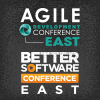Agile Development Conference & Better Software Conference East 2012

PRESENTATIONS
|
Form Follows Function: The Architecture of a Congruent Organization
One principle architects employ when designing buildings is "form follows function." That is, the layout of a building should be based upon its intended function. In software, the same principle helps us create an integrated design that focuses on fulfilling the intent of the system. Ken Pugh explores congruency-the state in which all actions work toward a common goal. |

Ken Pugh, Net Objectives |
|
Games Software People Play: Reasoning, Tactics, Biases, Fallacies
As engineers and doers, we make rational, well-thought-out decisions based on facts and figures. Or do we? Philippe Kruchten has identified not so rational strategies and tactics software people use while developing new, bold, and complex software-intensive systems. In addition to strategies such as divide-and-conquer, brainstorming, and reuse, Philippe has observed some strange tactics, biases, and reasoning fallacies. |

Philippe Kruchten, Kruchten Engineering Services, Ltd. |
|
Group Interaction Patterns: The Keys for Highly Productive Teams
Development teams often fail to recognize the complex group interactions and multi-person relationships that are critical to build and maintain a highly productive team. Instead, they adopt follow-the-crowd practices such as stand up meetings or Kanban boards without understanding the underlying fundamentals. Michael Wolf introduces group interaction patterns of highly productive development teams to provide a framework for understanding group interactions and a vocabulary for discussing ways to improve. |
|
|
Information Obfuscation: Protecting Corporate Data
With corporate data breaches occurring at an ever-alarming rate, all levels of organizations are struggling with ways to protect corporate data assets. Rather than choosing one or two of the many options available, Michael Jay Freer believes that the best approach is a combination of tools and practices to address the specific threats. |
|
|
IT Governance and Compliance in an Agile World
Establishing IT governance and compliance practices is essential for organizations that have regulatory or audit requirements. The good news is that you can be agile and still comply with Sarbanes-Oxley, CFR 21, HIPAA, and other regulatory imperatives. Done well, IT controls actually help you improve both productivity and quality. Bob Aiello describes how to implement IT controls in frameworks such as ISACA Cobit and ITIL v3 that many regulatory frameworks require-while maintaining agile practices. |

Bob Aiello, CM Best Practices Consulting |
|
It's a Phone First! How to Test Your Five-star Mobile Apps
Mobile application development shares many similarities-and some stark differences-with traditional web-based development. To build, test, and deploy five-star mobile applications, your organization needs-from inception-a focused test strategy to drive quality. Employing the wrong approaches and tools can leave your business sponsors and clients wondering what went wrong. Will Hurley outlines the current mobile landscape and explains what can and cannot be controlled in the mobile lifecycle. |
|
|
It's About Products Not Projects: Product and Portfolio Roadmaps
If you are managing your portfolio using projects, and not products, you may be missing opportunities to deliver more business value to your organization. Product and portfolio roadmaps are a strategic tool that you can use to align business goals and value to product delivery plans. |

Ellen Gottesdiener, EBG Consulting, Inc. |
|
Lessons From The Trenches – The Do's And Don'ts of Agile Outsourcing
Due to its ongoing rise in popularity 'Agile' methods are now being used on a wide range of projects, varying in size and complexity. As a result it's not uncommon for key project areas, like development, testing, UX, etc to be outsourced to 'on' and 'off-shore' companies. And although the decision to outsource is sometimes the right one for a project, outsourcing also comes with its own inherent risks. Using real world examples based on personal experience, Ade Shokoya will be sharing the do's and don'ts of agile outsourcing. |
|
|
Lessons Learned from Forty-five Years of Software Measurement
Counting is easy. However, what makes measurement really valuable-and really hard to get right-is knowing what to count and what to do with the results. If your organization is mostly tracking resource usage, costs, and schedule data, it is making a big mistake. What about the users? The customers? The overall business strategy? Sharing the lessons he has learned from fighting-and surviving-many software measurement battles, Ed Weller offers a step-by-step approach for implementing a practical and valuable metrics program. |
|
|
Leveraging Core Values for Healthier, More Productive Teams
Although all teams require a healthy level of interaction, high-performing teams' interactions are all based on trust, respect, and shared goals. Such teams find ways to overcome the fear of conflict, and quickly identify and resolve issues that are getting in the way. Scott Ross shares how, when the Omnyx software R&D department determined their culture was hindering performance, they crafted a core values statement that has served them well for the past three years. |
|


